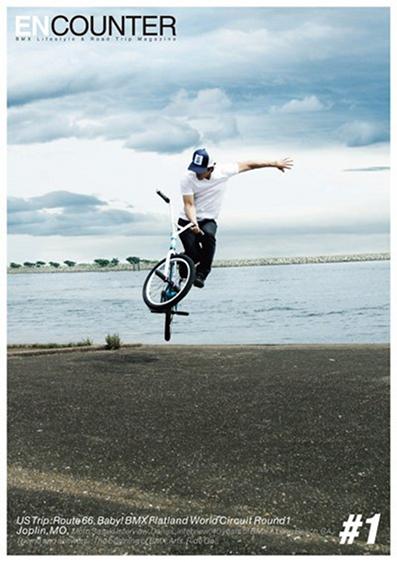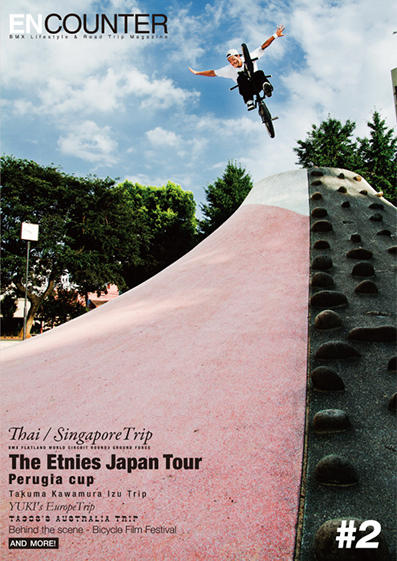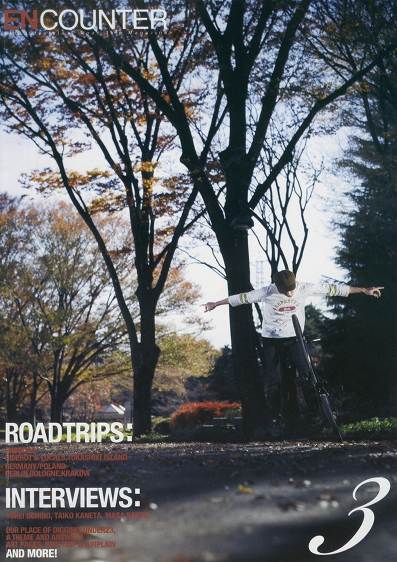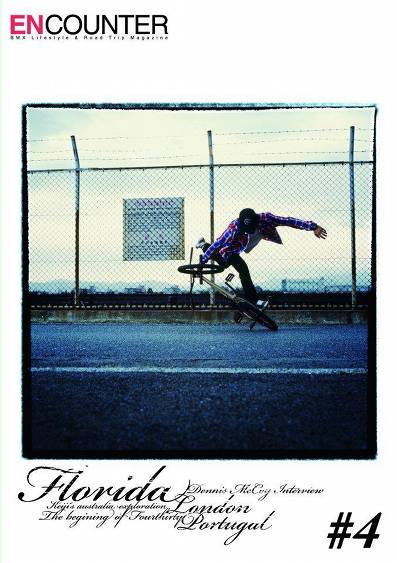
US Trip - BMX Flatland World Circuit Round 1, USA.
Hajime Sasaki Daisuke Yoneda interview.
Tanaka, Alain Masabova, Takashi Ito, Fat Tony.
40 years of BMX.
Fat Tony, fattonyenterprise.com, july 2011: I’m really excited about this one… Yasu “Green-G” Takeo from Tokyo just launched a brand new BMX magazine called Encounter, and I am featured in an article where a handful of BMX industry types discuss what got them into BMX and how it changed their lives. It is a huge honor to be a part of something like this and to have my name and story right along side of iconic Japanese riders like Takashi Ito and Hiroshi Uehara.

Contents include: Thai/Singapore Trip: BMX Flatland World Circuit Round 3 and Ground Force Singapore, The Etnies Japan Tour,Smile for Future, Perugia Cup, Takuma Kawamura Izu Road Trip, Yuki's Europe Trip, Taco's Australia Trip, Spotlight, Ride On, Behind the Scene: Bicycle Film Festival, Theme & Answers: Chad Degroot, Kaoro Maruya, Alain Massabova, and more. The Etnies Japan Tour article mentions a DVD, this was only available with a small number of copies exclusively in Japan.
76 pages, perfect bound, full colour, 90kg coated paper. All articles in English & Japanese
Effraim Catlow, www.flamattersonline.com, march 2012: It is pretty much a given that every week we see a new amazing flatland edit or a clip come out of Japan. The land of the rising sun is widely recognised as leading the way in flatland. As much as they do that in terms of contests, jams, bmx schools and video edits, we have never seen much in terms of printed media. I recall there was Dig-it magazine in the 90¢s, that was almost impossible to get ahold of. With that being said. It was with great pleasure that I was asked to review a new magazine out of Japan, called “Encounter”. The magazine is currently on its 2nd issue. I hear you already, is it written all in japanese… No, there are english and japanese texts to all the articles in the magazine, all articles are translated!
First impression? The magazine is very cleanly laid out, full colour magazine, on a really nice glossy paper. Clean cut. Simple design. Perfect binding. Very professional. Gave me the feel of an up market BMX magazine/booklet.
So what’s inside? Intro – Editor, Yasu “Green G” Takeo writes about the concept of Encounter. “Recording Challenges, struggling at creation, finding out something through BMX and travelling, a general theme of life is found in it. I believe this point of view would lead our magazine to being timeless”.
Flatland related articles: The BFWC Groundforce contest in Singapore gets a great double page spread, really nicely laid out collage of photos, Yasu captures the contest well with typically a great photo of Moto with Matthias Dandois pondering his next move after. The text largely focusses on the background going into Groundforce, it was however the text that went into the contest mindset that stuck out for me “Matthias Dandois and Moto Sasaki faced off. Moto’s concentration was unusual. Moto totally mimicked Matthias combo after Matthias’s run gave him pressure. Matthias failed to fight back in his run and Moto pulled off his harder tricks dialled. Matthias was totally stumped. That’s the game.” No one really talks about the psychological in flatland, so I found this although, just a short text, it was great to read.
York Uno and Calvin Tan both have full page photographs on the following page.
Great double page spread “Smile for future” a project supporting the victims of the Tohoku Region Pacific Coast earthquake. Put together by Yohei “Ucchie” Uchino who himself was a victim of the Hanshin earthquake in 1996.
Ucchie teamed up with fellow rider and great friend, Kotaro Tanaka to visit several disaster areas in Tohuku, and joined volunteer works to help support the local community. Personally I found this very moving, and another great side of flatland and bmx, helping others in greater need. I’m sure this article could have taken up the whole page. It is great to see professional riders giving back! Brilliant!
Without a doubt the highlight of the magazine for me, is a seven page article entitled “A Theme and answers”, riders discuss memorable tricks. The article features riders such as Chad Degroot, Alain Massabova, Shinichiro Hara, Hiroshi Uehara, Takashi Ito, Hiroya Morisaki, amongst others.
Chad Degroot discusses the “Darkside” – and also the decade, “It was a good session one random day. Then I was falling and didn’t want to put my foot down so it hit the bars and the backend swung up. Almost naturally I jumped to the pegs. After a few tries it was easy and looked cool as hell. It then spawned the front to back and back to front variations. To this day I still do that trick almost every time I ride, it just flows and feels sweet. Therefore the most memorable trick in my eyes is the Decade over 20 years ago. While the most memorable trick for myself personally is the Darkside.”
Alain Massabova discusses the Time Machine, and it’s origins. “A man named Jesse Puente made history by doing the time machine on the pedals in 1994, he was the man! Thanks to Kevin and Jesse for pushing this trick. We’ve come full circle, a time machine on the pedals is just a like a spinning cherrypicker or pedal picker!”
Shinichiro Hara writes about the whiplash turbine, he recalls how a friend called him from the USA and broke the news Kerry Gatt was doing something similar. he talks about stopping the trick for five years when it became popular. It took him 5 years to realise a different way to do the trick, to make it his own again. I think as flatlanders we can all relate to that moment when your heart sinks, yes somebody already did the move you’ve been working on for so long. Its documented, it’s out there. This case in point, Kerry Gatt, Baco 9.
Hiroshi Uehara of 430 clothing and Hiroya Morisaki discuss the decade, the decade appears to the most popular choice for memorable trick in this article. And you can understand why. “My most memorable and favourite trick would be the “decade”. It was the first trick I mastered. As my friends were trying this trick, I knew how strong the accomplishment felt after you pull it. Eager to learn, I swore to myself that I wouldn’t stop riding until I mastered it."
Hiroya recalls “I was in a football club and had trainings after school. I would later practice tricks under the lights at the car park of a local electrical shop. With lots of injuries on my legs, I practiced everyday and I mastered the “decade” in 3 weeks. The feeling of achievement was something I had never experienced. One of the motivations when I try new tricks is this feeling of achievement. Yes I did it, but strangely I did not know the name of this trick, so I named it “CC Lemon” after the TV commercial.”
Takashi Ito has deep roots in the growth of flatland in Japan. Unlike everyone else, Takashi talks about the “Waving move”, “The rider who polished up the ” and “waving movement” and completed it as a historical concept was Yanmar (Ryoji Yamamoto). He tried “Paddling” which was also similar to waving earlier than any other riders and integrated them into his combos. From then on, Flatland started evolving into a “new era”.
Takuma Kawamura Izu Road trip through the picturesque Izu peninsula, has 6 pages which relates back to Yasu’s intro…”Recording Challenges, struggling at creation, finding out something through BMX and travelling, a general theme of life is found in it. I believe this point of view would lead our magazine to being timeless”.
Takuma writes “During travelling, “gut feeling is the key. Right or left, to stop or go, to talk or leave, you always have to choose. This sense will probably be more developed the more you are on the road. I want to encourage all of you who hesitate to set off. Why don’t you develop your own “travel sense?”
Keita “Kane” Uchino has a full page bio to round up the flatland coverage in issue 2 of Encounter magazine.
As with all reviews on FM. I concerntrated on the flatland side of things, there is of course much more content besides. It is great to see a legit magazine come out of Japan. What is even better is the magazine is available over here! I hope to see more issues in the future! This is definitely one for the collectors out there!

Takio Kenata on the cover.
Contents include: Okinawa Road Trip, Germany/Poland Trip, Yohei Uchino Interview, 662 Trails, Under 23 Contest, Theme and Answers: The Moment You Decided to Live on BMX, Masahiro Sanpei Interview, G-Shock Real Toughness, Taiko Kanete Interview, Arts, BMX Trip Tips, Break Time, Messengers Voice: Yuki's Life.
72 pages, perfect bound, full colour, 90kg coated paper
Effraim Catlow, www.flamattersonline.com, july 2012: Issue 3 of Encounter has been out a few weeks now. And every issue is getting better and better, this might well be in terms of flatland content, the best flatland magazine out right now! Takio Kenata gets the cover shot, so rad flatland is on the cover!
Editor, Yasuyuki Takeo writes in this months editorial he did not intend a theme to run through each issue, but for this issue, “living as a professional” became the accidental theme. The situation has changed in japan, and riders as old as 30 are able to make a living off BMX.
Okinawa Road trip – Yasu flew down to Okinawa to enjoy the picturesque beaches, and of course cover the lifestyle and riding of the Okinawa locals, with some great photos of two emerging names on the japanese scene, Fumiya Kanna and Takuya Higa.
The highlight of this issue is one of the best interviews I have ever read with Yohei Uchino that covers 8 pages with great photographs and layout. Yasu did an amazing story to tell Ucchie’s story coming up as a pro rider… I’ll cover this as best I can for all of you, as I found it fascinating for all of you that don’t manage to get hold of the magazine. This may read as an article in it’s own right. Yasu writes for the intro… “The “spaceark league” was one of the biggest local contests held in Kobe by local bike shop “Spaceark” a while back. I clearly remembered a young rider who rode fast with technical moves on the front wheel looking so confident one would even be mistaken for arrogance. He was Yohei Uchino aka Ucchie. 10 years on, Ucchie now lives as the second generation of Japanese Pros and is also considered one of the top 5 Flatland riders in the world. Encounter asked how he found his way to live as a professional and achieving to be “ing” one of the best.” The interview begins talking about his past as a mogul skier, and swimmer. “It wasn’t fun when we played sports such as basketball or soccer as some of us were already top level in these fields. We decided to start something none of us had ever tried. I once happened to find information to a skateboarding contest but it turned out actually to be a BMX jam.” Ucchie goes to discuss that 2 years later once he had the BMX bug, a local pro rider Aki Kotani, said to him “You are talented, You could be number 1 in the world if you get serious about riding”, this piece of advise and motivation changed Ucchie’s life, and he began to put more and more time into flatland riding. After Ucchie graduated high school, he moved out of home. And moved in with Sharlee (the crazy KOG announcer), for a few months he observed how other Pro riders (Hiroshi Uehara, Takashi Ito, Akira Okamura and Kotaro Tanaka made their living. He eventually decided that Kotaro’s lifestyle fit his way of life and what he wanted to do the best. For a while he worked for Kotaro voluntarily for about a year, at this time Kotaro started his own brand “Nidd” and hooked Uccie and Yasushi Tanabe onto the team. He got his real first break when Takashi Ito was unavailable to do a show, and Kotaro asked Ucchie to fill in the empty spot. Ucchie recalls “soon after, Kotaro and I were doing shows regularly together as Takashi moved out to Okinawa. We had about 300 shows a year, sometimes up to 6 shows a day for different clients during hectic times. At that moment, I had just turned Pro at KOG but didn’t have any good results. I hardly made a living, only surviving through shows.” So your thinking, so what was his big break? “A TV commercial for UNIQLO. I was luckily chosen from 2000 performers from various fields. I had to attend filming for both on a long term, so I finally quit my job at the swimming school when I worked since I came to Tokyo, living off BMX full time, KOG was then held in KObe for the first time in that year. I have never qualified until then, but I managed to qualify 4th and won by completing my 3 best combos in the finals. I couldn’t even pull those 3 combos often during practise. Subsequently more job offers came after.” So at this point he was living low in his words. He began to get offered sponsorship contracts, he recalls “Good results are the fundamental requirement for support. But personality is rather more important” said the person who dealt with sponsorship contracts at Puma. Yasu asks, “We had not seen you after the victory at KOG in 2005. He headed to flatground and the world championships in prague, “But I was totally knocked out”, he recalls “he was totally overwhelmed by the atmosphere. I fully recognised that victory was far even if I did my best run”. Ucchie went back to Tokyo and continued his commitment to the international contest scene, wanting to make his mark. “the obsession with better tricks haunted me though I had already links that are supposed to be good enough in a contest. I switched to the rear wheel in 2005 but contented doing shows with only front wheel tricks. Only a few riders knew of my challenge then and some people even rumoured that “Ucchie had quit” as they barely saw me. In 2007, I moved out to near my riding spot and rode 8 hours a day when I didn’t have shows. There were no memories besides riding in 2007, I didn’t drink, just practised everyday. Actually I wondered if the effort eventually paid off after this”. Fast forward to 2008, and the first round of the World Circuit in New Orleans, the Voodoo Jam! “I qualified 8th but the battle tournament was the toughest ever. The first match up was with Hiroya Morisaki, who was crowned the first BMX Flatland World Circuit champion the year before. The next rider in the 2nd heat was Justin Miller, who was one of the best riders at that time and his riding can be described as a machine. The semi final was my first match up with Matthias Dandois, who was invincible then and lastly in the finals I battled the king of consistency and spinning, Matt Wilhelm…. I spent most of the prize money at the party (laughter). Alain Massabova moved quickly and hooked up Ucchie, this was his first bike sponsor with salary. After his win at Voodoo “I could buy a car and lived a decent life”. The next question is possibly what we have all wondered, but no one asks “You’ve been hitting all the World Circuit contests, but not the KOG, why?” “My ideal goal is to become the BFWC champion first before attending all KOG contests…”The value would depend on how you see it. To me the BFWC is like part of my job, where I simply aim for the best results. While the KOG is more emotional, it’s my roots of BMX. I don’t want to get bored competing at KOG. Thats why being a KOG champion is the last goal for me.” The interview concludes with what he will do after riding and advice for younger riders. I’ve covered this interview as best I can as I truly do think its worth getting this magazine just for this interview, its gripping stuff. And made me realise how little I know about Ucchie, and it’s also a great story, that’s shows the sacrifice he made for many years to be a pro rider.
The next flatland article is all about the “Under 23 contest, which was founded by Ucchie! There are short interviews with the top three, Yuki Ito, Taiko Kaneta, and Takuji Izumi. As well as Koh Yoshida who decided to step down as organiser this year. The layouts and text are more in-depth his issue as the magazine has grown and matured. It kind of reminded me of how Cream was back in its peak. Under 23 contest gets 4 pages, where Ryuta Iwasaki, writes ann interviews riders about the history of the Under 23 contest. It is now in its 8th year. It began in 2004 with Yohei Uchino then 21 starting the concept to help improve the level of younger riders. Yet another example of pro rider giving back to his scene and helping the next generation come through. Theres a short interview with organiser Koh Yoshida and they discuss his decision to step down this year from organising the contest. He has some great advice/words of wisdom for younger riders toward the end of the interview “I feel that some young riders are passive. Having being part being part of organising contests since I was 18. I’ve felt that certain riders take it for granted events are being run by someone see and they do not really care about what’s going on behind the scene. Edtitors note: I couldn’t agree more! The article ends with short interviews with the top three on the podium, Yuki Ito, Taiko Kaneta, Takuiji Izumi. This article gave me the same feeling as when I used to read the old Creams. So much good stuff within 4 pages. Great research and information into what goes into an event like this. Really informative article.
Each issue of encounter, has some kind of “Theme and answers” article, ad this issue asks the question “The moment you decided to live on BMX, with one page issue dedicated to the likes of Hironao Doko, Takashi Ito, Susumu Moroioka, Motoaki Tanaka, and Fat Tony. Takashi’s story of joint York, as York started AresBykes stood out the most for me, and his realisation as York and Takashi got better results hitting up the X trials circuit they could live a professional, very much echo’ing what Ucchie was saying earlier, less the personality statement.
Yuta Yoshida covers the G Shock Real Toughness event in Toyko, with nice photos of Dominik Nekolny, Kotaro Tanaka, Ucchie (yes Ucchie has so much coverage this issue!)….
Flip one page and its another banging interview, this time Taiko Kaneta is the subject matter. And a very interesting interviewee at that. Yasu writes: “Can I help you? It was 2005 at the KOG in Fukushima, a skinny young boy amongst 3 kids asked during preparation of the contest. The boy with unclouded eyes worked silently, his names was Taiko Kaneta. A couple of years later, Taiko moved out to Tokyo to study Buddhism in college and began bringing out his talent at contests. taking advantage of his dynamic rear moves, he was quickly recognised as one of the top riders at the KOG. One day, I heard a rumour that Takio had to quit riding. He is the eldest brother and is supposed to work at his parents temple after graduating from college. Once he started training, he won’t be able to ride or even communicate with the outside world for 1 or 2 years.”. The interview naturally focusses on what Taiko will do in the future, possibly changing his path in life “It is basically heredity and the eldest brother generally takes over.” His family expect a lot of him as the eldest brother, something that has troubled him. He went to India to go and see the birth place of Buddhism, and was a wake call to him. They discuss death, dealing with the March earthquake, its pretty heartfelt stuff. Yasi changes the subject to riding, and his last contest competing, the Under 23 contest…. “I aimed for victory as I had never won at contest. I was in good shape, but I ended up in 2nd. Everybody cheered me on the most just as in KOG, so I am totally contented with the result. I’m in the happiest moment of my BMX life. They go to discuss KOG, and he says he can’t compete with top pros such as Viki Gomez, Ucchie, and Matthias Dandois “I don’t think about living off BMX, these pros fully dedicate their lives. Although I gave up on victory, I still try to impress people. I don’t save myself for good results. I always try new and hard tricks as I would for a video”. They discuss this latest edit, his hometown scene in Sendai, growing up with KOG pro rider Masatoshi Karino, and finish the the interview with advice to riders from his generation “Once you progress enough to control your bike, it is still fun riding alone although theres something missing for me. You should be more active to participate in whatever opportunities are round you, jams, contests, or just riding with everybody. Looking back now that I would have to leave riding for a while, I often reminisce the time I spent with everyone like that.”. Great words to close a fascinating interview. Which closes the flatland related content for Issue 3 of Encounter. Which really is taking off where Cream left us I feel. Japan as we all know is the heartbeat of flatland riding, this magazine reflects that, and reflects it really well and in a mature way. Looking towards the bigger picture, these riders and their scene seem to get it. And this one reason why flatland is so big there. Big respect. If you like printed magazines as much as me, you will try your best to get ahold of this, it truly is worth the effort.

Florida Trip - Hiroshi Uehara, the owner of Fourthirty and the head judge of KOG visited Chad Degroot, a legendarily flatland rider at Florida.
DMC Interview - An interview of Dennis McCoy, aka DMC. Asking about the behind scene of Dew Tour.
Hiroshi Uehara Interview - Hiroshi Uehara is the founder of Fourthirty. He currently owns 3 shops and his brand, Fourthrity is known as the one of the famous street apparel in Japan. But he started his brand from 1m x 1m space at his senior's brand 10 years ago.
UK / Estonia trip - Trip to Simpel session via London, UK.
Portugal Trip
A theme and answers - Asking KOG champions about the past, present and future of KOG.
Keiji's Australia Exploration - Keiji is currently living Australia and hit the road to explore Skateparks and the nature.